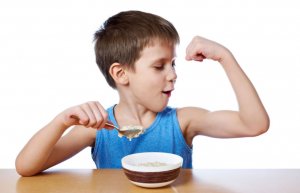Nutrition in Children and Adolescent Athletes

Professionalism in the sports field isn’t just for adults. Consider that today, there are several child divisions that forge the athletes of the future. Just as it happens in high demand sports, the nutrition in children and adolescent athletes should also be monitored.
Children require a greater amount of energy boosting foods
In general, a child’s physical activity is much longer and intense. While adults focus their energies on limited workouts and competition days, children spend the energy in their bodies every day. That is to say, their regular hours of play should be added to their training.
We must also include the feeding rations that children need to continue their growth process. Therefore, the amount of protein and carbohydrates they need is greater than that of an adult.

The correct daily ratios would be 55 percent of carbohydrates, 20 percent of proteins, and up to 25 percent of fats. As we can see, the proportion of carbohydrates and fats must be higher for children. This type of diet may have its variations; for example, if a child is very thin, the ration of fat can increase.
Nutrition in children and adolescent athletes: immediate and reserved energy
The nutrition in children and adolescent athletes must meet two requirements: immediate and reserved energy. The first is spent with daily activity and the second is stored to forge the metabolic processes of growth. Additionally, we know that children consume five calories for each gram that they gain.
For example, children between 10 and 14 years of age who play soccer can consume up to 540 calories per day. The problem is that not all children have a good appetite and most choose their food according to taste. This way, the challenge always remains on the side of the parents.

It’s also necessary to know which minerals and substances may present a greater deficit in your kids. The ones that frequently display a shortage are vitamins B12, E, zinc, and folic acid. This is where we must focus a little more of our attention.
How should the daily meal plan of a child athlete be?
Although the proportions vary noticeably to that of the adults, the daily plan may be similar. The first thing is that a child’s daily diet should contain five food intakes. The mid-day meal will be the heaviest and should be complemented with a kind of post-breakfast snack.
For children, dinners can take place between 8:30 pm and 9:00 pm. From a nutritional aspect, they should avoid complex carbohydrates, however, there may be some flexibility for the smaller athletes.
Regardless of age, it’s advisable to use olive oil for frying and to avoid drinking an excess of sugary beverages. Meals should be accompanied mostly by water, although the correct action is to keep many types of liquids at bay. The first meal in the morning should include natural fruit juice.
How should an adolescent’s diet be?
In reality, an adolescent’s diet is similar to that of an adult rather than to a child’s. From the age of 15 up to 18 years, an athlete consumes much more energy. Consider soccer again, we’re talking about 790 calories per day. Conversely, their likelihood of having obesity problems also increases.

Up to 23 percent of adolescents may suffer from being overweight. Hence, the intake of carbohydrates and fats should be somewhat moderate. Yet, we can’t forget that at these ages, young people are still in full development.
To combine all of the previous aspects, the daily distribution of food will be fundamental. In the case of young people, it’s best to plan good breakfasts and light dinners. Everything will also depend on the morphology of the athlete.
To summarize, nutrition in children and adolescent athletes should be planned and controlled. Otherwise, they could have incidents of weakness during sports practice or an episode of early obesity.
Professionalism in the sports field isn’t just for adults. Consider that today, there are several child divisions that forge the athletes of the future. Just as it happens in high demand sports, the nutrition in children and adolescent athletes should also be monitored.
Children require a greater amount of energy boosting foods
In general, a child’s physical activity is much longer and intense. While adults focus their energies on limited workouts and competition days, children spend the energy in their bodies every day. That is to say, their regular hours of play should be added to their training.
We must also include the feeding rations that children need to continue their growth process. Therefore, the amount of protein and carbohydrates they need is greater than that of an adult.

The correct daily ratios would be 55 percent of carbohydrates, 20 percent of proteins, and up to 25 percent of fats. As we can see, the proportion of carbohydrates and fats must be higher for children. This type of diet may have its variations; for example, if a child is very thin, the ration of fat can increase.
Nutrition in children and adolescent athletes: immediate and reserved energy
The nutrition in children and adolescent athletes must meet two requirements: immediate and reserved energy. The first is spent with daily activity and the second is stored to forge the metabolic processes of growth. Additionally, we know that children consume five calories for each gram that they gain.
For example, children between 10 and 14 years of age who play soccer can consume up to 540 calories per day. The problem is that not all children have a good appetite and most choose their food according to taste. This way, the challenge always remains on the side of the parents.

It’s also necessary to know which minerals and substances may present a greater deficit in your kids. The ones that frequently display a shortage are vitamins B12, E, zinc, and folic acid. This is where we must focus a little more of our attention.
How should the daily meal plan of a child athlete be?
Although the proportions vary noticeably to that of the adults, the daily plan may be similar. The first thing is that a child’s daily diet should contain five food intakes. The mid-day meal will be the heaviest and should be complemented with a kind of post-breakfast snack.
For children, dinners can take place between 8:30 pm and 9:00 pm. From a nutritional aspect, they should avoid complex carbohydrates, however, there may be some flexibility for the smaller athletes.
Regardless of age, it’s advisable to use olive oil for frying and to avoid drinking an excess of sugary beverages. Meals should be accompanied mostly by water, although the correct action is to keep many types of liquids at bay. The first meal in the morning should include natural fruit juice.
How should an adolescent’s diet be?
In reality, an adolescent’s diet is similar to that of an adult rather than to a child’s. From the age of 15 up to 18 years, an athlete consumes much more energy. Consider soccer again, we’re talking about 790 calories per day. Conversely, their likelihood of having obesity problems also increases.

Up to 23 percent of adolescents may suffer from being overweight. Hence, the intake of carbohydrates and fats should be somewhat moderate. Yet, we can’t forget that at these ages, young people are still in full development.
To combine all of the previous aspects, the daily distribution of food will be fundamental. In the case of young people, it’s best to plan good breakfasts and light dinners. Everything will also depend on the morphology of the athlete.
To summarize, nutrition in children and adolescent athletes should be planned and controlled. Otherwise, they could have incidents of weakness during sports practice or an episode of early obesity.
This text is provided for informational purposes only and does not replace consultation with a professional. If in doubt, consult your specialist.








